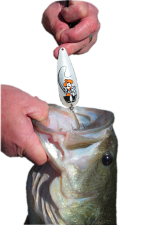The Effects of Turbidity on Piscivores
This page describes three related research projects investigating how turbidity (suspended particles such as clay) effects piscivores in lakes and reservoirs. Turbidity can change rapidly in aquatic systems, affecting the visual ability of predators. Increased turbidity is known to reduce reactive distance and foraging success of some planktivores and insectivores, leading to decreased growth rates. Other planktivores have their highest foraging success at intermediate turbidities as this provides an ideal background for prey detection. Little is known about the effects of turbidity on prey selection by piscivores. These studies quantify the effects of turbidity on piscivore foraging return and prey selection.
Effects of turbidity on prey selection and foraging return of piscivorous largemouth bass
Project personnel: Drew Lane, Dan Shoup
Shoup, D.E. and Lane, D.W.* 2015. Effects of turbidity on prey selection and foraging return of adult largemouth bass in reservoirs. North American Journal of Fisheries Management. 35:913-924.
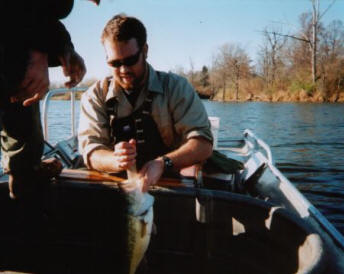
We examined the effects of turbidity on consumption rates of largemouth bass Micropterus salmoides in laboratory pools and prey selection in field samples. Predator consumption rates were tested separately at each of five turbidity ranges (0-2.9, 3-6.9, 7-10.9, 11.0-14.9, >15.0 NTU) for each of two prey species (gizzard shad Dorosoma cepedianum or bluegill Lepomis macrochirus) in 2-m diameter laboratory tanks, using a repeated-measures design. For each trial, 10 prey of the same type were added to each to tank. Individual predators were allowed to consume prey for 24h after a 24-h acclimation period at each turbidity level. At turbidity levels <15 NTU largemouth bass typically ate 1-2 prey within 24 h. At 15-20 NTU there appeared to be a shift in the predator’s ability to detect prey and all trials >20 NTU resulted in a significant reduction in foraging rate. Most predators ate no prey during the 24-h trials conducted at turbidity >20NTU and daily consumption was below published daily ration levels for largemouth bass. These results suggest that a largemouth bass’ ability to detect and capture prey is significantly reduced at higher turbidity levels.
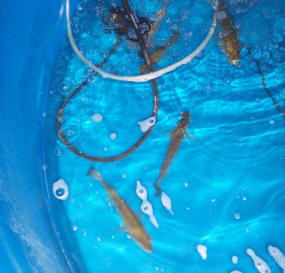
To determine the effects of turbidity on prey selection and foraging rate of largemouth bass in reservoirs, stomach contents of largemouth bass Micropterus salmoides were examined in two reservoir systems (Boomer, Sooner and Guthrie Lakes) to assess how turbidity effects prey selection. Reservoirs were electrofished multiple times at different turbidity levels during a 7-week period (to ensure the prey base was similar) in two years. In Boomer Lake, largemouth bass ate a greater proportion of crayfish and other fish at lower turbidities in both years and a greater proportion of centrarchids or gizzard shad at higher turbidities in one year but not the other. In Sooner Lake, a greater proportion of centrarchids were used in more turbid water in one year but the other when no turbidity-related effects were detected. Crayfish dominated the diets of largemouth bass from Sooner Lake both years. Largemouth bass in Guthrie Lake used other fish more at higher turbidities. These results suggest that reservoir food web dynamics may be altered by changes in turbidity in some systems.
Past project: Effects of turbidity on prey selection by piscivorous largemouth bass
Project personnel: Dan Shoup, Dave Wahl
Shoup, D.E. and D.H. Wahl. 2009 The effect of turbidity on prey selection by piscivorous largemouth bass. Transactions of the American Fisheries Society. 138:1018-1027.

We examined interactions of largemouth bass Micropterus salmoides with prey in 1.8-m diameter tanks (58-cm deep) at four turbidity levels (0, 5, 10, and 40 NTU). Prey selectivity was significantly affected by turbidity. At lower turbidity levels (0 and 5 NTU) largemouth bass consumed mostly gizzard shad Dorosoma cepedianum and bluegill Lepomis macrochirus and had negative selectivity for crayfish Orconectes virilis. At 10 NTU, all three prey types had similar selectivity, presumably caused by increased difficulty in capturing rapidly moving fish prey as reactive distances decreased. At 40 NTU overall foraging rate was greatly decreased, and bluegill were selected significantly more than the other prey types. Low light levels at the bottom of the tanks combined with visual clarity reductions from clay sediments likely made it difficult for largemouth bass to feed effectively on crayfish at higher turbidities. Our results suggest that trophic interactions may be altered as turbidity levels change.
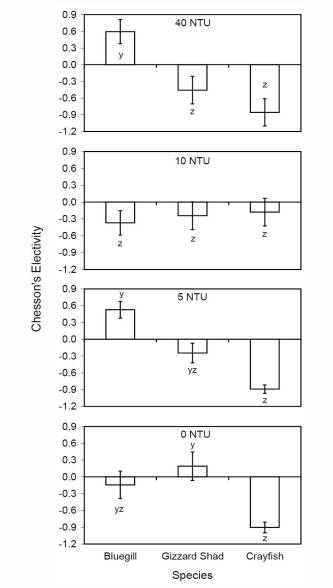

Chesson electivity values for largemouth bass foraging on bluegills, gizzard shad, and northern crayfish at different turbidities, arranged by turbidity level. An electivity value of +1 indicates that that prey type was the only one consumed, a value of -1 that that prey type was avoided altogether, and a value of 0 that there was no selection for or against that prey type. The bars represent means and the thin vertical lines SEs; means with different letters within the same panel are significantly different (P < 0.05).
Past project: Effects of Turbidity and Cover on Prey Selectivity of Adult Smallmouth Bass
Project personnel: Mark Carter, Dan Shoup, Dave Wahl, John Dettmers
Carter, M. W.*, Dettmers, J.M., Wahl, D.H., and Shoup, D.E. 2009. Effects of turbidity and cover on prey selectivity of adult smallmouth bass. Transactions of the American Fisheries Society. 139:353-361.
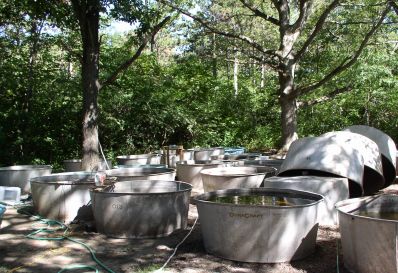
Environmental factors such as turbidity and habitat complexity affect many aspects of aquatic food webs including predator-prey interactions. We examined the effects of turbidity (0, 5, 10, 20, 40 NTU) and cover (presence or absence) on prey selection of adult smallmouth bass Micropterus dolomieu (287 ± 40 mm) in laboratory pools. Individual predators were given a choice of five each of crayfish Orconectes virilis, golden shiner Notemigonus crysoleucas (a pelagic fish), or round goby Neogobius melanostomus (an invasive benthic fish). Smallmouth bass selected round goby at low turbidities (0 and 5 NTU) and golden shiner at the highest turbidity (40 NTU) in trials without cover. With cover, smallmouth bass increased selectivity for golden shiner, particularly at the turbidity extremes (0, 20, and 40 NTU). Crayfish were negatively or neutrally selected in all trials across both turbidity and cover treatments. Turbidity had a greater effect than cover on prey consumption rate, decreasing as turbidity increased. Our results suggest that turbidity and cover, two important environmental variables, can influence prey selectivity in smallmouth bass.
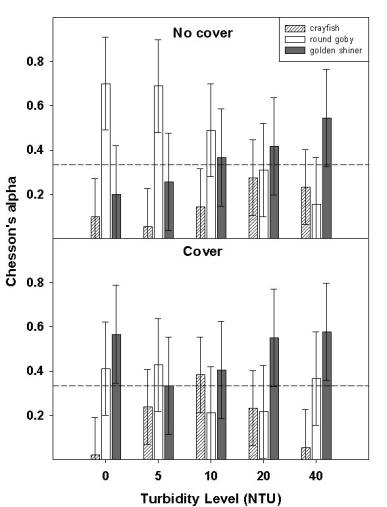
Mean and 95% confidence intervals for Chesson’s alpha in trials without cover (top panel) and with cover (bottom panel) across five turbidity treatments. Prey selectivity is presented for crayfish (light bars), round goby (open bars), and golden shiner (dark bars). Selection was assessed by overlap between 95% confidence intervals and the dashed neutral selection line (1 / number of prey species tested).


